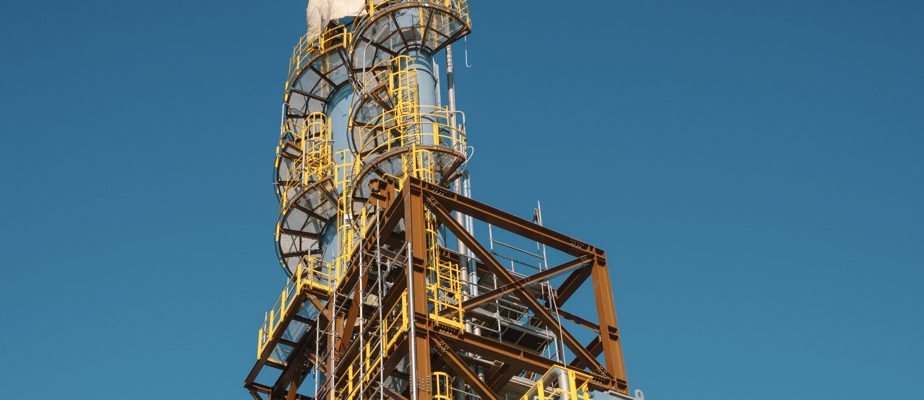Renowned for its ancient churches and the tomb of Dante, 14th century poete century, the region of Ravenna, on the Adriatic coast of Italy, also has ancient industries, such as steel and fertilizers. The factories are of little interest to the many tourists who contribute to the region’s economy, but they employ tens of thousands of people.
But for how long ? These factories, like others in Europe, face increasingly strict standards on CO2. The costs of new regulations could cause them to close.
“We are very afraid for the future of our industries,” says Michele de Pascale, mayor of Ravenna. Yes, we must reduce CO emissions2, but we want to do it without destroying our industries. »
The Italian energy giant Eni, with a strong presence in Ravenna, is proposing a plan which, according to the mayor, could help the survival of regional heavy industry: devoting the region to CO sequestration2.

PHOTO MAURIZIO FIORINO, THE NEW YORK TIMES
Technicians install a CO capture device2 in an Eni gas processing plant, set to become a CO sequestration center2 in Casalborsetti, Italy.
Eni wants to build a network of pipelines that would transport CO2 emitted by factories to depleted gas fields. For Eni, this process – also called carbon capture and storage – represents a promising business sector that would help it transition to cleaner activities.
Eni is working on similar projects elsewhere in Europe, notably in Britain, where there are many depleted oil and gas fields.
There are other carbon sequestration sites around the world, including in the United States and Canada: most aim to reduce emissions from the oil and gas industry.

PHOTO MAURIZIO FIORINO, THE NEW YORK TIMES
The port of Ravenna is an important industrial center, and Eni wants to build a network of pipelines there that would transport CO2 emitted by factories across the region to depleted gas fields 20 km offshore from the city in the Adriatic Sea.
Eni wants to move away from oil and gas, its historic activity – the cause of climate change – but faces an uncertain future. Management considers itself advantaged because it can use its existing infrastructure (wells and pipelines) and reassign employees. “It’s very easy to reskill or replace staff,” says Claudio Descalzi, CEO of Eni.
Mr. Descalzi wants to make carbon sequestration a secondary activity that could attract other investors. He estimates profits could reach around 10% per year.
According to Mr. Descalzi, the energy transition will only succeed if it generates sustainable businesses: “Otherwise, it will fail. Resources are limited, we can’t spend money. »
Eni operates around fifty gas platforms in the Adriatic Sea, off the coast of Ravenna, beyond lagoons populated by pink flamingos. As gas deposits become depleted, Eni intends to trap CO2.

PHOTO MAURIZIO FIORINO, THE NEW YORK TIMES
Claudio Descalzi, CEO of Eni, wants to make carbon sequestration a secondary activity whose profitability could reach 10% per year. “It’s very easy to reskill or replace staff,” he says.
The company invests 100 million euros (147 million CAD) to capture around half of the CO2 currently emitted by its Casalborsetti gas processing plant, near Ravenna. The work is completed: a new well will soon be used to inject CO2 in an old gas field 20 km offshore, 3000 meters below the seabed.
If this first phase goes well, Eni will move on to a much larger project, valued at at least 1.5 billion euros (2.2 billion CAD). We will connect factories and other big polluters in Italy and perhaps even France, in order to pump up to 16 million tonnes of CO under the seabed.2 per year.
To model CO injection2 in porous rocks, oil experts use 3D imaging computer models similar to those used to plan natural gas extraction.
But these carbon sequestration projects encounter difficulties: the energy sector, like those of cement and steel, will be more difficult to clean up than electricity production. This shows that the energy transition is a huge challenge.

PHOTO MAURIZIO FIORINO, THE NEW YORK TIMES
To model CO injection2 in porous rocks, oil experts use 3D imaging computer models similar to those used to plan natural gas extraction.
According to the International Energy Agency (IEA), carbon sequestration must account for 8% of cumulative emissions reductions for the world to achieve net zero emissions by 2050. To do this, the volume of CO2 stored must be multiplied by 20 by 2030, to reach 1 billion tonnes per year – “a very ambitious objective”, estimates Carl Greenfield, analyst at the IEA.
Polluters struggle to assess whether it is worth spending hundreds of millions of euros to modernize their factories. “They don’t even have the expertise to understand what the best technology is,” says Eni COO Guido Brusco.
Eni is participating in an emissions reduction plan financed since 2020 by the British state, targeting in particular the Liverpool and Manchester regions. As part of this project, HyNet North West, Eni would build and manage a 65 km pipeline in which CO would circulate2 polluters in the region to take it to sinks located under Liverpool Bay. Eni claims to have reached a preliminary agreement under which the British government guarantees it a profit.
Many environmental activists and researchers believe that greenhouse gas emissions must be reduced at source by investing instead in renewable energies. But some of them concede some merit to carbon sequestration, as long as it does not serve to prolong the use of fossil fuels.
“If the release of CO2 by a factory is inevitable, so it’s better to sequester it,” admits Doug Parr, chief scientist at Greenpeace UK.
This article was published in the New York Times.
Read this article in its original version (in English; subscription required)
